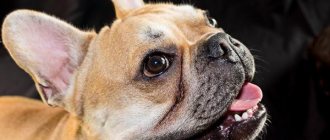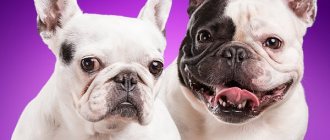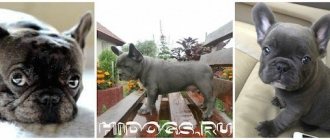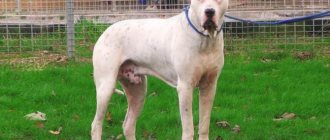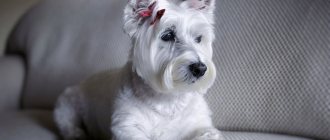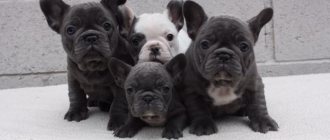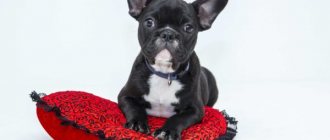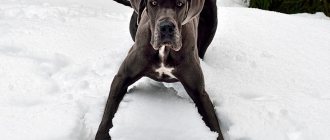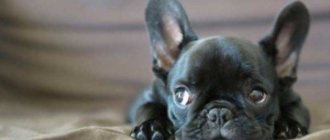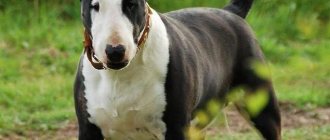The French Bulldog is a small breed.
Outwardly, they are similar to English bulldogs, but in miniature.
These dogs have gained popularity due to their compact size, unpretentious maintenance and absolute friendliness of character.
French Bulldogs were created by crossing an English Bulldog and a Spanish Bulldog.
Initially, this is a small-format fighting dog.
However, thanks to its size, it looked original in competitions and amused people.
General form
Let's look at what a French bulldog looks like.
Despite their small stature, these dogs have a strong, muscular build. At first glance, it becomes clear that this is a lively and very lively animal with a courageous character. Moreover, males are somewhat larger and more massive than females, whose torso is more stretched.
The large and massive head has a square outline. On the short muzzle there is a forked flat nose. But the French bulldog has an excellent sense of smell - with the help of smell it gets acquainted with the outside world. The dog's upper lip is also divided in half. The eyebrows and eyes are separated by a deep furrow that does not extend to the frontal part. The bump on the back of the head is almost invisible. The dark, large and bulging eyes of the dog are characterized by an intelligent and kind expression. Strong, square-shaped jaws have an overbite.
The ears of dogs of this breed resemble in their shape the ears of bats: they have an erect position, with a wide base and rounded ends. The dog's powerful neck is quite short, slightly less than the length of its skull. The French Bulldog has such a feature as a naturally docked tail - it is broken naturally.
The French Bulldog has a lower height at the withers than the height at the rump. That's why he looks a little squat. A slightly arched back, a developed loin and a slightly raised croup give solidity to the bones of this animal. The wide and voluminous chest of representatives of this breed has a cylindrical shape.
Characteristics and description of the breed
The homeland of small bulldogs is the English city of Nottingham, where they were bred and lived until the 19th century. With the advent of scientific and technological progress, some Nottingham workers immigrated to France, taking their pets with them. Bulldogs settled in Paris and were officially considered "poor man's dogs." But their stature, agility and compactness attracted the attention of dog breeders, the breed began to be studied, the first standards for the appearance of bulldogs appeared, and over time they acquired the status of ranking dogs. Noble families began to purchase them, and breeders began breeding them seriously.
Two "French" and "English". Photo from an early 20th century newspaper
The list of requirements characterizing the purity of the breed gradually changed, and only by the beginning of the 20th century did the official FCI (International Canine Federation) standard appear, which is known to the world today.
French bulldog bitch
Description of the breed (ICF standard)
French bulldogs are classified as indoor and decorative breeds. They are ranked on the same level as Pekingese, poodles and pugs, although they are fighting dogs. A single standard has been established for the breed.
Table 1. Unified standard of external indicators for French bulldogs.
| Index | Standard |
| Weight (1 kg deviation in any direction is acceptable) | 9-14 kg – for males, 8-13 kg – for females. |
| Height (1 cm deviation in any direction is acceptable) | 27-35 cm – for males, 24-32 cm – for females. |
| Body type | Strong, clearly defined muscles, strong, short limbs (the hind legs are longer than the front ones). The chest is wide, descending below the elbows. The stomach is tucked. The sacrum is higher than the withers. |
| Tail | It is short, has a kink from birth (no need for docking), is located low, and does not rise when emotions are expressed due to the structural features of the body. |
| Ears | Triangular, directed vertically upward. They have rounded ends. They don't stop. Located at a considerable distance from each other. |
| Eyes | Dark brown in color, round, large. |
| Mouth | When closed, a purebred bulldog's tongue should not be visible. |
French bulldog breed standard
Color
Initially, the classification is based on the number of colors included in the dog's color. It can be solid or spotty. There are only two underlying colors:
- brindle;
- pale yellow.
Attention! The fawn color was officially recognized only in 1995. Previously, it was considered a sign of lack of purity of the breed.
French bulldog brindle color
Both color options include white spots of varying diameters. It is preferable to have them symmetrically located on the bulldog's body. Possible presence of specks. Dogs with a fawn base always have black spots on their face, arranged in the shape of a mask. Fawn color has a wide range - from light tones to bright red and brown.
Fawn color range
Spotted French Bulldog color
Endangered and rare species
The main task of breeders is to breed genetically pure and healthy individuals capable of producing strong offspring. Many cynologists have tried to manipulate color, because modern science makes it possible to read the genotype of living creatures and combine genes as necessary. But it was found that certain combinations of genes that give rise to rare and popular colors in French bulldogs give birth to sick individuals with congenital malformations. This fact became the basis for a ban on the breeding of certain colors of the breed, and if such an individual was nevertheless born, it was not considered a purebred. She had no official right to reproduce.
Prohibited colors include:
- lilac;
Lilac French bulldog puppies
- blue;
- merle;
Merle puppy
- chocolate and other combinations of the above shades.
Important! Brindle and fawn are the only color options for French bulldogs recognized by the FCI.
What are these dogs for?
French Bulldogs are designed for fighting and hunting. Our ancestors used this breed as beaters when hunting small animals. In English factories in the 18th and 19th centuries, small bulldogs were bred instead of cats in order to combat rats in production.
A little later, the fighting abilities of the “Frenchies” were noticed and they were taken to the dog ring. Today this sport is actively developing.
If you want to get a French bulldog, you should know: he needs long walks (up to 1 hour) and physical activity. To pacify the hunting temperament, competent training will be required; without it, the Frenchie can become dangerous for his relatives (he attacks dogs while walking).
French bulldogs
Colors
The French Bulldog is mainly variegated in color - brindle or spotted. There are also uniform colors. White spots are allowed in the area of the head and on the chest - the so-called “tie”.
If representatives of this breed have a white coat color, then there is no depigmentation on the eyelids, lips, nose and croup. If the animal has a spotted color, there should be a mask on the animal’s face – a kind of “glasses”.
The standard description of the characteristics of a dog of this breed says that colors such as gray-blue or mouse, any shades of blue, chocolate, tricolor, merle, and Isabella are unacceptable.
Physical activity
French bulldogs love to play and run without a leash. But when going for a walk with such a pet, it is necessary to take into account the breed characteristics of dogs of this breed. Like all brachycephalics, the “Frenchies” have a short, wide muzzle, which is why they have a limited reserve of stamina. Such a dog can run for a short time or play outdoor games, but long runs in a park or stadium are not for it.
Great physical activity in the summer poses a particular danger for the “French”. Due to the typical muzzle structure of brachycephals, they already have a hard time in the summer, and if the pet also runs outside in the heat, then it may develop serious problems with the respiratory or cardiovascular system.
In addition, French bulldogs should not jump over obstacles, as they have a breed defect such as an additional hemivertebra. Sometimes even several of them can develop, and this significantly increases the risk of back injury or even a spinal cord herniation. Also, when walking and playing outdoors, you should stay away from bushes. After all, due to the fact that French bulldogs have rather bulging eyes, the dog can injure them on branches.
French bulldog puppies under one year of age should not be overly loaded or, especially, put on harnesses with weights.
The best exercises that perfectly develop your pet's muscles are climbing a gentle hill or stairs. And if the owner is absolutely sure that his dog does not have additional hemivertebrae, jumping to low heights can also be added to these activities. During a walk, it will also be useful to throw a ball or other toy so that the dog will run after it. However, it is necessary to monitor the bulldog’s condition and when the first signs of fatigue appear, you need to give him a rest or return home with him.
Short story
It is generally accepted that French Bulldogs are a smaller variety of English Bulldogs. Like their cousins, French bulldogs were bred to participate in animal fighting. Gradually, thanks to British connoisseurs of this breed, they moved from fighting dogs into the category of decorative dogs.
Some researchers claim that among all the ancestors of modern French bulldogs there are also Spanish bulldogs that have not survived to this day. Surprisingly, French bulldogs originate from England. The first owners of dogs of this breed were English dressmakers, who used them as pets living in the house and able to catch small rodents.
Then many dressmakers left for France, taking with them small bulldogs, where the French nobility noticed the dogs. After this, the breed began to gain popularity, the price of these dogs began to rise, and soon only the upper strata of society could purchase a French bulldog. It was in France that the first official registration of dogs of this breed took place.
The exhibition, in which French bulldogs took part for the first time, took place in 1896. It was hosted by the Westminster Kennel Club.
In the twentieth century, French bulldogs came to Russia and also quickly gained fame, which made them extremely expensive dogs. With the establishment of Soviet power, dogs of this breed began to disappear. By the end of the Great Patriotic War, only one French bulldog named Flick lived in Moscow.
In 1948, a dog of this breed was brought to Russia from Hungary. After which S.N. Sklifosovskaya took up the revival of French bulldogs. In 1965, she was able to bring a male of this breed from England named Foleyfram Henry, and in 1967, a female from Poland. It is these dogs that are considered to be the parents of the revived line of French bulldogs.
In 1972, MGOLS (Moscow City Society of Amateur Dog Breeding) was founded, in which, along with other decorative breeds, the French bulldog was registered, which appeared there as a result of the reorganization of hunting clubs.
History of the breed
As the excitement around dog fighting died down, when selecting puppies from a litter, preference began to be given to calm, human-oriented ones..
And soon these little dogs became the favorites of English seamstresses. Not only were they companions and pets, but they were also excellent rat catchers.
The difficult financial situation in the country at the end of the nineteenth century forced some residents to immigrate to France.
So, the mini-bulldog that appeared in England moved to France and elite courtesans were the first to have them as a cute, lively accessory.
Through these ladies, the dogs found their way into high, aristocratic society, where they gained recognition from wealthy gentlemen. A boom in the breed began.
Having a French bulldog at home was considered the latest fashion.
The final popularization among the masses occurred after the breed came to America, from where these dogs became famous throughout the world.
Temperament
Energetic representatives of this breed have a friendly, cheerful character. Both families with children, single people, and disabled people can afford such a pet. Tactful dogs of this breed subtly sense the emotional state of the owner and are able to protect him in a dangerous situation.
At the same time with such excellent characteristics, the French bulldog is courageous, daring and savvy. His peaceful nature makes him a gentle and loyal friend. Possessing a bright temperament, French bulldogs enjoy spending time with their family, appreciating attention and responding to it by demonstrating their charisma.
In describing the characteristics of the French bulldog, we can also add that this dog has a very calm character. In an extreme situation, she will not panic, since these animals have no fear.
Despite these advantages, representatives of this breed also have negative qualities - they behave like children and can be offended at any time, for example, by a lack of attention from the owner. But if he corrects this, then the pet will forget about his bad mood and will look happy.
Before buying a puppy
Before you decide to purchase a French bulldog puppy, you must clearly understand what responsibility you are taking on, since this dog has a rather unique character and requires increased attention.
French bulldogs are very active and temperamental by nature, so you must devote a lot of time to socializing and walking with them, otherwise this may affect the degree of aggression and the overall psychological well-being of the pet. In addition, these dogs are very sociable, which at the same time becomes a problem: they tolerate loneliness very hard.
Observe the puppy's behavior: he should be active and playful
If you are planning to purchase a purebred dog, you must evaluate the possibilities of your budget, since the French bulldog requires special maintenance: special food, play equipment, regular visits to the veterinarian, etc. All these costs can add up to a pretty tidy sum.
You must also clearly understand that when purchasing a dog, you take full responsibility for its life and health. Only when you realize this fact and feel that you are still “burning” with the desire to fill your house with joyful dog squeals, can you safely go to the breeder.
Adaptation
In describing the characteristics of representatives of this breed, it should be noted that French bulldogs use intelligence and ingenuity not for performing official duties, but for socialization in the outside world. And a dog’s sense of smell is the first assistant in this matter. The French bulldog sniffs everything, determining by smell whether a given object or person is suitable for him.
Such pets, despite the ideal balance of activity and calmness, constantly require attention from the owner and household members. Loneliness is unbearable for them.
The French Bulldog can be hostile towards other dogs and strangers. On the street, it will be difficult for the owner to restrain his pet’s aggression towards other animals. But if the owner communicates nicely with a stranger, then the dog will be able to get used to him. French bulldogs have a hard time getting used to other pets. The best option in this case is for them to live together from a young age.
Representatives of this breed treat children with tenderness, and can even babysit very young family members. But the dog’s games with children under six or seven years old will have to be constantly monitored. When a dog gets tired of enduring a bad attitude, it begins to respond by biting.
Security qualities
A French bulldog can become a good guard for an apartment . Indeed, despite its small size, it is fearless, and its hoarse bark, reminiscent of the voice of a large dog, can scare off an intruder who encroaches on the safety of the owner or the safety of his property. Bulldogs are not inclined to bark at the slightest noise, and if an intruder decides to break into the house, most likely, the dog will not waste time barking at him, but will immediately try to bite.
At the same time, in ordinary life the “French” are not at all malicious. They will never attack passers-by on the street or guests who come to the house. These dogs understand perfectly well when aggression is appropriate and when such actions should be refrained.
French bulldogs do not know how to correctly assess the degree of danger and often get into fights with larger dogs or other obviously stronger opponents.
Therefore, the owner, if he is nearby at the time of the conflict and sees that the pet can be seriously injured in a fight, needs to intervene and stop him.
Coat care
The French Bulldog's coat requires minimal grooming. Brush it once every seven to ten days with a massage brush to remove dead hair. After all, representatives of this breed are prone to constant shedding.
Bath the dog once every two to three months using shampoo. The rest of the time, if it is heavily soiled, you can use a damp cloth or dry shampoo.
French bulldog colors
The breed standard allows the following colors:
- brindle;
- spotted;
- pale yellow.
The remaining colors (white with black spots, mouse, smoky, liver, blue, tan, pure black) are defective, which does not affect their popularity among connoisseurs of the breed.
The most common colors are white, blue, fawn and brindle.
Below you can see descriptions of what this or that color looks like, as well as photos with examples.
White
Purely white color is extremely rare.
As a rule, the color is represented by snow-white or milky-white shades. The spots on the dog's body can be any color (but not black), and there is often a dark mask on the face. This color is genetically recessive.
Representatives of the white coloration have good immunity.
Gray
Gray coat color is widespread.
The color is represented by gray shades of varying degrees of severity (from light gray to metallic), monophonic. The coat is short, shiny, and the hairs are the same gray color throughout.
Dogs may have small white spots on the chest (but most often there are no spots or a mask).
Redheads
The red color is a common variation of the fawn color.
Dogs have a black mask on their face. The wool is uniformly colored in a rich copper-red shade. White spots are allowed on the puppy's body, except for the chest, neck and belly.
Blue
Blue Bulldogs have not been recognized as a standard color, but are becoming increasingly popular.
Blue coat color is a variation of gray and comes in various shades, but the most common is “blue clay color.” Often this beautiful color is combined with blue eyes.
This color is monochromatic, but puppies may have small spots of white on the chest.
Black
Black coat color is not a single color - in fact, dogs have variegated colors of varying degrees of intensity (variations of dark brown, brown and tan, black and tan). The intensity of the shade depends on the genetic characteristics of the dog.
Beige
The beige color of the breed was recognized as standard only in America.
NOTE!
The beige color is similar to the fawn color, but differs from it in the different coloring of the tip of the nose, eyelids and lips of the dog. When they are beige they are cream in color, while when they are fawn they are black.
Beige representatives do not have a black mask and are born light red (evening out and lightening the tone to beige occurs gradually).
Chocolate
Chocolate color is a uniform, rich brown or brown-brown color with a slight shine. Variations in shade are possible, but it will always be monochromatic.
Chocolate-colored dogs have longitudinal white spots on the neck and belly, and there is no mask on the face.
Merle color
Merle (merle) is a marbled coat color. It is a genetically dominant trait and is not recognized as a standard.
Merle coloring is uneven, tricolor and is represented by fuzzy spots of various sizes and shades, most often alternating coffee, white and brown. There is usually no mask.
Often representatives of this color have heterochromia (different colors of the iris), as well as other genetic abnormalities.
Brindle
Brindle is the most common color. It is represented by a variegated alternation of red and black stripes on the dog’s body. Light (“milky”) markings are allowed on the chest and neck; there is a dark mask on the muzzle.
Brindle color is inherited as a dominant trait. Puppies with this coloring are distinguished by good health, mobility and unpretentiousness.
Fawn
The fawn color is represented by a rich range of colors from light coffee to red. Within each color there can be both light and dark fawn shades.
A fawn colored dog may have a dark mask or a small number of small white patches on the chest and neck. The belly is white.
With this color, the hairs have a red color of varying degrees of intensity and length. Short ones are lighter, long ones are darker. The tips of the hairs are often gray in color.
Any variation of fawn color must be uniform. Fawn color can be either recessive or dominant. Varieties: fawn brindle (fawn color dominates) and variegated fawn (black color dominates).
Education and training
French bulldogs are not the best dogs to train and raise, as they have a stubborn character. Intelligence and ingenuity allow these dogs to remember a lot, but they do not always have the desire to follow commands.
To make any sense from training a dog of this breed, the owner will have to constantly go through the same lesson with him. And only around the thirtieth or fortieth time will the pet be able to finally remember the command and begin to carry it out unquestioningly. But you will still have to repeat the material covered, otherwise the pet will again begin to shirk its responsibilities.
What does your pet look like? What is his character? Share with us in the comments.
If you liked the article, please like it.
Dimensions and other features
Grow up to 33-35 cm at the withers with a weight of 8 to 14 kg.
This is a powerful, stocky dog of small size. The bones are strong, the muscles are highly developed.
The head is square in shape, wide and massive. On the front part, the brow ridges are noticeably pronounced, separated by a furrow between the eyes.
The nose is snub-nosed and the nose is black . The nostrils are open and wide. The eyes are large and dark. When the dog is looking forward, no whites should be visible. Eye rims are black.
The ears are turned forward and set high . The ears are wider at the base and rounded at the end. The tail is short, but covers the anus. Straight at the base and tapering as it lengthens.
The coat is smooth, without undercoat.
The dog’s movements are free and powerful, but not abrupt..
Read a more detailed description of French bulldogs here.
Care and maintenance
The French should pay special attention to hygiene. Therefore, he needs to be taught these procedures from the first day he appears in the house. You should systematically examine your pet’s ears, and treat them with ear sticks as they become dirty.
Your pet's eyes require daily treatment with moisturizing wipes.
Teeth are the Bulldog's weakest point and need to be looked after carefully and regularly. They are prone to various diseases and rapid wear.
For this reason, the dog should not be fed bones. For preventative purposes, teeth should be brushed with a dog toothbrush, and the animal should also be given treats with a cleaning effect. The dog's nails should also be trimmed.
Nutrition
The calorie content of the menu depends on the dog’s lifestyle. If she is active, then it should be more nutritious than that of a couch potato. The main product is meat, it should make up 60-70% of the daily menu. The best option is considered to be low-fat rabbit meat, lamb, horse meat, and veal. It can be given raw.
Calculating the daily dose is simple. It is 20 grams per 1 kilogram of animal weight.
Meat can sometimes be replaced with fish, but not more than 1-2 times every 10 days. River fish must be boiled, sea fish can be given raw. In this case, it is necessary to remove the bones from it.
The remaining 20-30% of the diet is filled with cereals, vegetables, and dairy products . The porridge can be anything, over time the pet will decide which one he likes best. It is advisable to cook it in water without salt, adding meat and vegetable ingredients at the end of cooking. During cooking, it is allowed to add vegetable oil.
Trying to diversify a pet's menu, owners have every chance of harming its health. For example, you cannot feed your dog dairy products and meat at the same time.
Milk should not be given to mature dogs; their stomachs have difficulty digesting it. Plant food (if the dog eats it) can be given both raw and boiled. Suitable: carrots, cabbage, eggplant and other vegetables. If your French Bulldog prefers fruit, it is best to give it as a treat. This will be an incentive for training.
There are several types of foods that should not be in a bulldog's diet:
- potatoes, onions and garlic;
- flour and confectionery products;
- smoked and pickled products;
- bones (tubular, hard);
- fatty meats (pork).
Food with seasonings, sauce, ketchup, as well as fried and fatty foods are undesirable.
If dry food is used, you should choose only high-quality products. If your dog has allergies, you should pay attention to hypoallergenic products; they are available in the holistic food line.
We recommend that you read a detailed article on the topic: “How and what to feed a dog: types and characteristics of nutrition.”
Health
This is a fairly healthy breed. But if you don’t care for her properly, she’s unlikely to live long. That is why you should be attentive to the care of your animal and its nutrition, get vaccinated on time and, if necessary, immediately contact a veterinarian.
Vaccinations
There are many known diseases that French Bulldogs can suffer from. Most of them can cause the death of a dog. Modern medicine makes it possible to protect animals from the most dangerous diseases thanks to a set of vaccinations against the following diseases:
- Rabies;
- Plagues of predators;
- Parvovirus inflammation;
- Leptospirosis;
- Infectious hepatitis;
- Adenovirus;
- Parainfluenza.
The following vaccination model is currently used:
- 6 weeks - immunization against enteritis, jaundice, adenovirus, after 14 days - secondary vaccination, then - a year later - every year;
- 10 weeks - anti-plague vaccination;
- After 16 weeks - vaccination against leptospirosis, after 6 months - revaccination;
- 7 months - vaccination against distemper, then a year later - every year;
- After 8 months - rabies vaccine.
Two weeks before vaccination, you should pay attention to the condition of the puppy. Is he active, how does he eat, drink, how many times does he go to the toilet?
It is also necessary to measure its temperature. The temperature of a puppy is normal at 38-39 degrees, for an adult dog at 38-40 degrees.
Treatment against parasites should be carried out 7-12 days before Because a puppy infected with worms may not tolerate vaccination.
Important article on the topic: “Everything you need to know about dog vaccinations.”
Diseases
Due to the special structure of the nose, eyes and body, the French Bulldog can develop health problems. Particularly common diseases include:
- Food insect allergy;
- Cataract;
- Dermatitis and suppuration of the fingertips;
- Turn of the century;
- Hypotrichosis (hair loss);
- Stones in the kidneys;
- Colds;
- Bracheocephalic syndrome;
- Obesity;
- Problems of spinal development.
Often puppies of this breed suffer from diarrhea, which can be caused by a sudden change in menu. In addition, diarrhea can be associated with infection, worms, colds, teething, and intestinal infections. This can be treated with activated charcoal and a dry diet. If the condition does not improve within a day, you should immediately contact your veterinarian.
Walk
It is not necessary to walk a French bulldog for a long time . These dogs are calm about being outside and can stay at home with their owner. However, you will still have to take it out a couple of times a day.
Due to the specific nature of the bulldog, you need to follow some rules when walking:
- Duration . Despite the common characteristics of the breed, each Frenchman has his own character. One is sociable and active, the other is a typical homebody. Therefore, how long a dog will walk depends on its character.
- Place of celebration . A lawn with dense soil is what you need for an active walk. It is healthier to walk on lawns, clearings and similar places than on asphalt. Do not overload the dog's spine with unwanted steps and crossbars. Moreover, this is contraindicated for puppies.
- Cloth . The Frenchie has short hair, so he is very sensitive to heat and cold. It is worth reducing the walking time at high temperatures. A warm jumpsuit will keep your pet warm in winter.
- Communications . It is worth introducing the dog to the outside world, other animals and people, and then walks will be a pleasure for both the dog and the owner. These dogs are practically not aggressive, but any desire to fight must be suppressed.
Grooming
It is not necessary to bathe your bulldog too often. After a walk, you should use wipes to clean the animal. Full bathing without special need is carried out once every 2-3 months. To do this, you should fill a bath of water or a basin and put the dog there. When bathing, be careful not to get shampoo into your eyes and ears. It is more convenient to wash off the foam from the animal using a watering can with low pressure. After bathing, the animal is wrapped in a towel, dried with a hairdryer and released into a draft-free room. It is better to take a walk after swimming 3-4 hours later.
Caring for the coat of this animal is not difficult. Dogs of this breed practically do not shed, and their fur is odorless. But if the fur becomes dull, dandruff and odor appear, then most likely the pet is sick. In this case, you need to consult a veterinarian and exclude all cosmetic substances.
A bulldog comb should have fine teeth . Even better is a massage brush. When a bulldog sheds heavily, it is better to bathe him with a special product. Brushing the coat with a massage brush will help remove loose hair. The French don't get their hair cut or shave. It is allowed to apply balms or conditioners to wet wool. Any product for dogs with short hair will do.
How to choose a puppy
The puppy should be picked up no earlier than 1.5 months from birth . By this time, he should be vaccinated and examined by a doctor. You should find out who the puppy’s parents are and what his pedigree is, how he was kept and what he ate.
You can determine whether a dog is healthy visually. In a healthy dog :
- Living identical eyes;
- The ears are clean and odorless;
- Black nose;
- Paws are straight,
- Coordinated movements;
- Pink oral cavity;
- Correct bite;
- Teeth without defects.
A healthy dog actively plays and has fun . The puppy is sociable and makes contact. It is worth paying attention that the puppy may react negatively to the touch of strangers, but will not show aggression.
In conclusion, it is worth saying that the French bulldog has always been considered a dog for high society. He was always the center of attention at parties. The sight of this dog evokes affection: its upturned nose, voluminous chest, and powerful paws. This little dog has all the qualities of a fighting dog and is ready to protect its owner at any time. A soft nickname will suit the Frenchman. This breed is quite suitable for those who are getting a dog for the first time or who lead a measured lifestyle. The Frenchie will easily fit into any family and will feel good even in a small house or apartment.
Are the French good swimmers?
Among the dogs of swimmers and rescuers, you will never meet a French bulldog, and this is not without reason.
The French can swim, but they do it vertically, as if standing on their hind legs.
The fact is that they have a rather heavy and massive head and developed muscles. If they swim like a dog, they will quickly go underwater upside down.
Moreover, swimming in a river, pond or sea can cause a skin or ear infection for your dog.
Video
* We invite you to watch a video about the French Bulldog . In fact, in front of you is a playlist in which you can select and watch any of 20 videos about a given dog breed by simply clicking on the button in the upper right corner of the window. In addition, the material contains quite a lot of photos. By looking at them you can find out what a French Bulldog looks like.
In this article:
|
Rate the material!
[Total votes: 1 Average: 1]
The French Bulldog is a friendly little animal that will quickly charm a dog lover with its cute little bat-like ears. He easily becomes attached to people and really needs communication. For a French Bulldog to be happy, it needs a loving and caring owner.
Features of character and behavior
Representatives of the breed are very active. They are famous for their openness and good nature. The French are quite smart, but difficult to train because they are not eager to obey their owner. This is because the breed was created not to carry out official commands, but to build unique social relationships between the pet and its owners, capturing their mood.
This breed is considered universally suitable for both large families and non-family individuals who are elderly or disabled.
Advantages
Keeping a representative of this breed has certain positive aspects:
- With good upbringing, they are capable of showing aggression towards other four-legged animals only in an emergency situation.
- They never raise their voice without reason, within the confines of the house.
- They easily find contact with children, participating in their games with pleasure, but within reason. It is better if such games take place under the supervision of elders in order to avoid unpleasant incidents.
- Smart, inquisitive, good and loyal friends. Obedient. However, in the character of a bulldog there is always a certain amount of laziness and stubbornness, which owners are advised to control through training and encouragement of their four-legged friend.
- Able to sense the mood of their owners.
Flaws
French bulldogs have a number of disadvantages that you should pay attention to when deciding to get such a pet:
- They are capable of showing character: upending the house during an outburst of excessive activity, biting if they don’t like something, getting offended.
- They are often lazy. Therefore, without timely training, they stop listening to the owner.
- They cannot stand loneliness and need constant attention. This breed is not suitable for breeders who do not have time to play with their pet.
- Fearless beyond measure - they can be maimed by representatives of larger breeds due to bouts of aggression.
- Not suitable for guarding a private home - the breed is designed to be kept at home.
